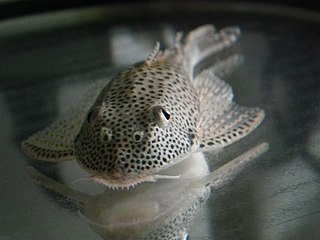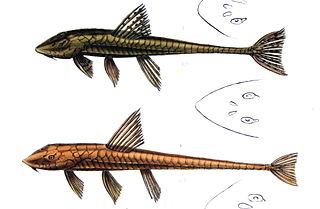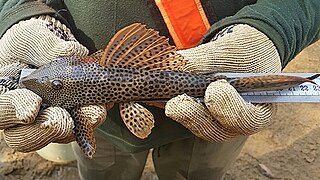
Ancistrus is a genus of nocturnal freshwater fish in the family Loricariidae of order Siluriformes, native to freshwater habitats in South America and Panama. Fish of this genus are common in the aquarium trade where they are known as bushynose or bristlenose catfish. In the aquarium hobby they are often referred to as bushynose or bristlenose plecos instead, but this may lead to confusion as "pleco" usually is used for Hypostomus plecostomus and its allies and is often used as a catchall term for any loricariids remotely resembling that species.

Loricariidae is the largest family of catfish, with 92 genera and just over 680 species. Loricariids originate from freshwater habitats of Costa Rica, Panama, and tropical and subtropical South America. These fish are noted for the bony plates covering their bodies and their suckermouths. Several genera are sold as "plecos", notably the suckermouth catfish, Hypostomus plecostomus, and are popular as aquarium fish.

Hypostomus is a genus of catfish in the family Loricariidae. They are native to tropical and subtropical South America. H. plecostomus is the popular freshwater aquarium fish formerly known as Plecostomus plecostomus. The taxonomic structure of the Loricariidae is still being expanded by scientists. Hypostomus is a highly species-rich and widely distributed catfish genus.

Aphanotorulus is a genus of armored catfishes native to the Amazon, Orinoco, Essequibo and Jaguaribe basins in South America. They typically occur on a sand or gravel bottom in slow to moderately flowing rivers and streams, but some species occur in areas with fast current. The largest species in the genus reaches up to 51 cm (20 in) in standard length.

Hemiancistrus is a genus of suckermouth armored catfishes. These species are native to South America. The taxonomy of this genus is complex and unclear, and major work has to be done. Many of these fish are popular aquarium fish.

Isorineloricaria is a genus of catfish in the family Loricariidae from northwestern South America. They live in rivers and streams, typically with slow to moderately running water, in the Orinoco, Maracaibo, Magdalena and Guayas basins. The largest species in the genus reaches up to 52 cm (20 in) in standard length.

Loricariichthys is a genus of catfishes of the family Loricariidae.
Hypostomus cochliodon is a species of armored catfish native to the Paraguay and middle Paraná River basins in northern Argentina, southern Brazil and Paraguay. Initially it did not occur in the upper Paraná basin above the Guaíra Falls, but these disappeared after the construction of the Itaipu Dam, allowing this species to spread. It grows to a standard length of 23 cm (9.1 in).

Isorineloricaria spinosissima, also known as the zucchini catfish, is a species of Loricariidae endemic to the Guayas River basin in western Ecuador. This species grows to a length of 56.5 centimetres (22.2 in) TL.
Aphanotorulus ammophilus, also known as the black spotted pleco or L094, is a species of benthopelagic tropical freshwater catfish in the family Loricariidae endemic to Venezuela, specifically the Río Orinoco drainage. Due to an initial erroneous publication, A. ammophilus was initially placed into Hypostomus instead of Aphanotorulus. However, because this species shows sexual dimorphism, has a relatively flatter shape, and has a jagged posterior edge of its oral disc, it was placed in the genus Aphanotorulus. A. ammophilus reaches 16.1 cm SL.
Hypostomus niceforoi is a species of suckermouth armored catfish. H. niceforoi reaches 13.5 cm SL and is believed to be a facultative air-breather.
Chaetostoma platyrhynchus is a species of catfish in the family Loricariidae. It is native to South America, where it occurs in the Caquetá River basin in Colombia. The species reaches 9.5 cm in total length. The species is known to be of disputed classification and spelling.

Aphanotorulus emarginatus is a species of catfish in the family Loricariidae. It is native to South America, where it occurs in the Amazon River basin. The species reaches 15 cm in total length. It is known to be a facultative air-breather.
Aphanotorulus gomesi is a species of catfish in the family Loricariidae. It is native to South America, where it occurs in the Jaguaribe River basin. The species reaches 14.3 cm SL. It is thought to be a facultative air-breather.
Aphanotorulus phrixosoma is a dubious species of catfish in the family Loricariidae. It is native to South America, where it occurs in the upper Amazon River basin. The species reaches 10.1 cm SL. It is believed to be a facultative air-breather.
Aphanotorulus unicolor is a species of catfish in the family Loricariidae. It is native to South America, where it occurs in the upper Amazon River basin. The species reaches 13.9 cm SL.
Hypostomus pantherinus is a species of catfish in the family Loricariidae. It is native to South America, where it occurs in the Madeira River basin in Brazil. The species reaches at least 4.8 cm in standard length and is believed to be a facultative air-breather. Although originally described by Rudolf Kner in 1854 based on a single specimen from the Guaporé River basin in Brazil, Hypostomus pantherinus was redescribed in 2021 and its range was found to also include Bolivia.
Isorineloricaria acuarius is a species of catfish in the family Loricariidae. It is native to South America, where it occurs in the Apure River basin in Venezuela. The species reaches at least 26.9 cm in standard length. It was described in 2016 as part of a taxonomic review of the genera Aphanotorulus and Isorineloricaria conducted by Jonathan W. Armbruster and C. Keith Ray. FishBase does not yet list this species.
Isorineloricaria tenuicauda is a species of catfish in the family Loricariidae. It is native to South America, where it occurs in the Magdalena River basin in Colombia. The species reaches 45 cm in standard length, can weigh up to at least 960 g, and is believed to be a facultative air-breather.
Isorineloricaria villarsi is a species of catfish in the family Loricariidae. It is native to South America, where it is known only from Venezuela. The species reaches 32 cm in standard length and is believed to be a facultative air-breather.







